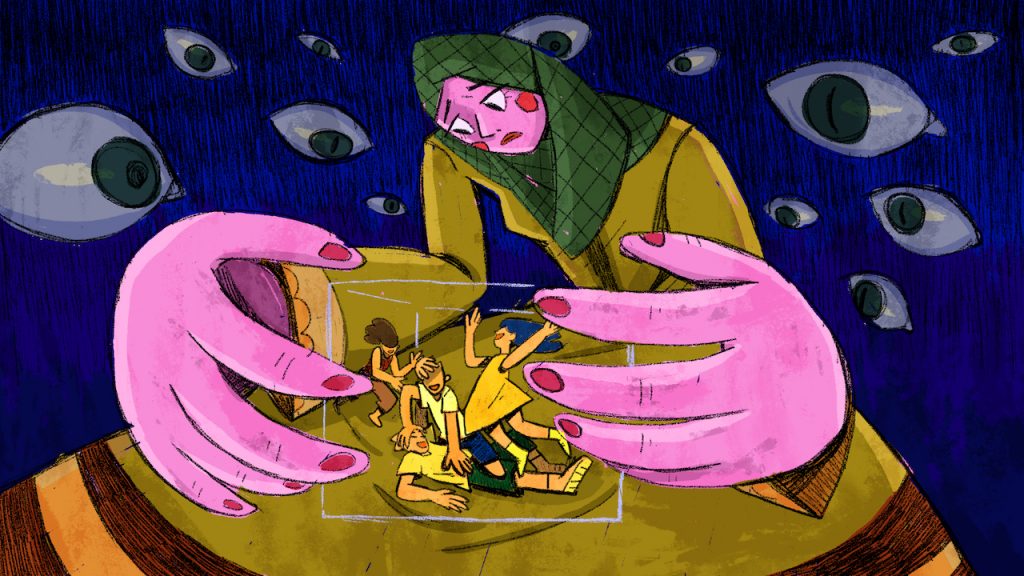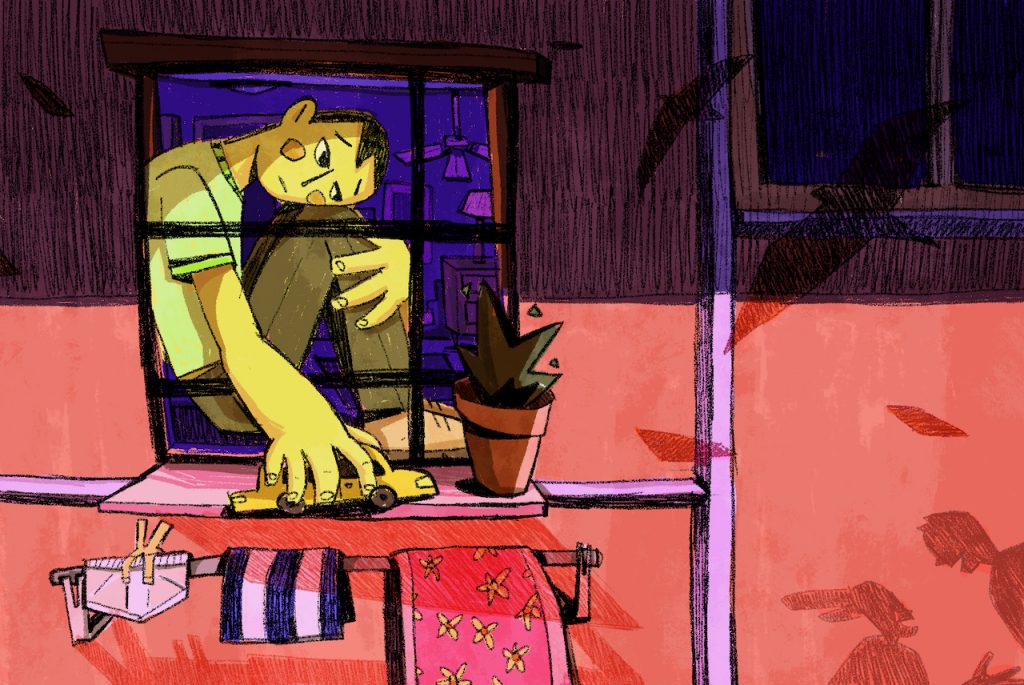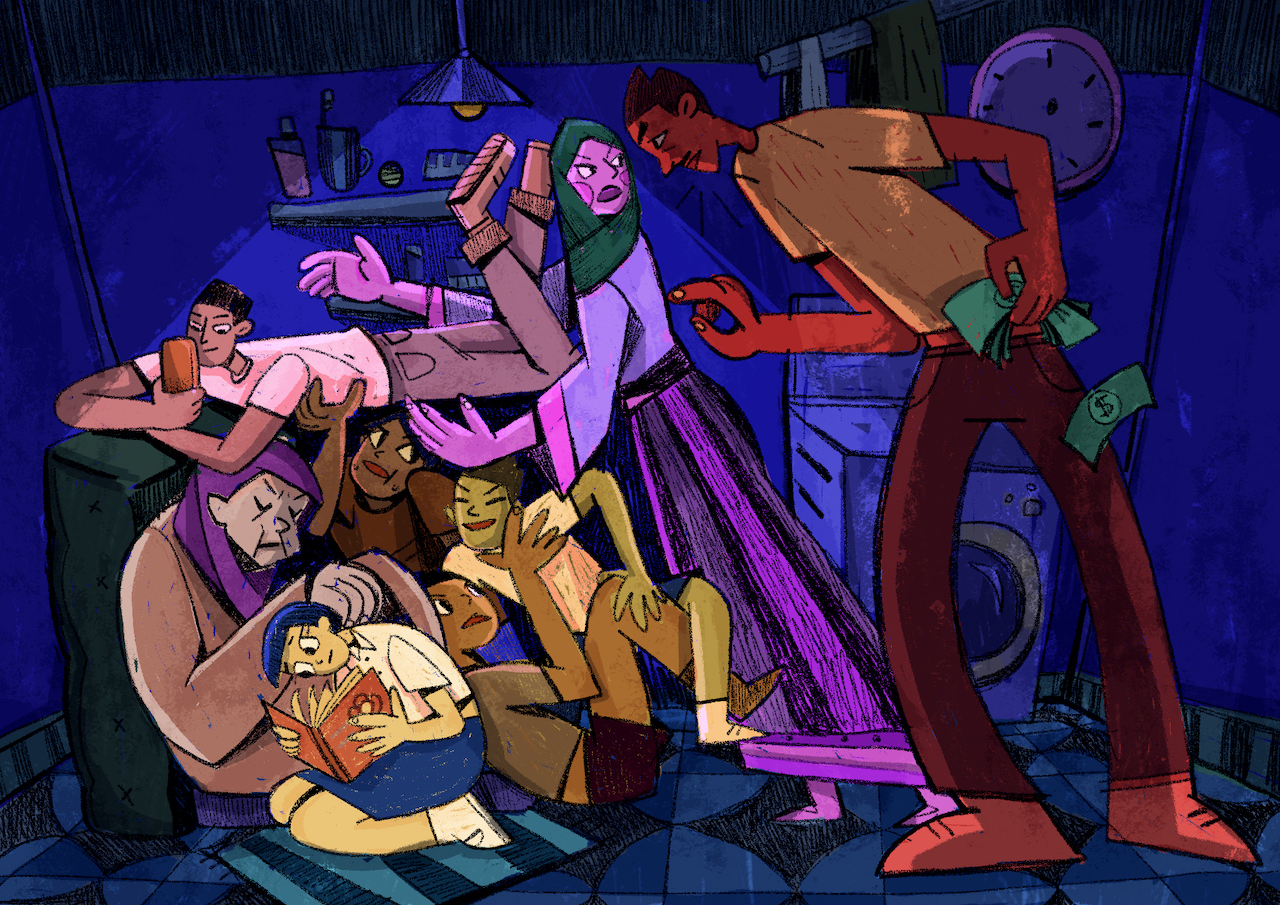The author is involved in a ground-up initiative in the Jalan Kukoh neighbourhood. All anecdotes in this article are based on first-hand observations.
Too young to be allowed to wander the estate alone, and without the resources for after-school care or enrichment activities, the children are confined to their 1-bedroom flat in the Jalan Kukoh neighbourhood. They shriek and roll on the ground in hysterics before Fauzi jumps to his feet. He sticks his tiny tush at Leila and wiggles it, flapping his elbows and shouting, “Bleebleeblableeahhh!”
Leila sits up, screeches appreciatively and flops back on the floor, breathless with laughter. Fauzi jumps on her. More shrieking.
A bunk bed stands against one wall, next to a stack of mattresses that leans against the window. The other walls are lined with cupboards and bookshelves. There is a child-sized table and chairs next to a bookshelf, directly opposite another bed which stands at the entrance to the kitchenette.
This setup is typical of many rental homes in the Jalan Kukoh area. The kids play on the few square metres of floor available to them.
A wizened figure on the bed turns and shouts. It is their bedridden grandmother, who is trying to nap.
They can’t make out the words, but the tone is angry. The children stop, chastened. Their mother, Aida, emerges from the kitchenette, where she has just fried bananas for them. Her mother-in-law turns on her, spitting in her wrath. Aida ignores her and sets the steaming plate on the floor of the living room, next to the grandmother’s bed, where the family of seven always eats. The children scamper to the food and start to giggle again.
“Leila, Fauzi, berhenti,” Aida says. “Naughty.” She closes her eyes.
The look of worry never leaves her face. She sits on the floor, where she is throughout the day. There is no chair she can recline in. Lounging is a luxury in a thirty-square metre space shared between three children, a teenager, and three adults.
Horseplay is a vital part of child development. It teaches a child the boundaries between healthy play and unacceptable violence. It has been found to promote brain development and emotional intelligence, among other benefits. Horseplay also helps to release pent-up energies from the school day, which can otherwise manifest as temper tantrums.
As a State Party to the United Nations Convention on the Rights of the Child (the Convention), Singapore recognises the right of the child to engage in age-appropriate play and recreational activities, accepting the importance of play to optimal development. Yet, in this overcrowded rental flat, the children’s need to play is stymied day after day as it comes into continuous conflict with their elder relatives’ needs. Their behaviour is labelled “naughty” for getting in the adults’ way, signalling that they should be ashamed of their perfectly age-appropriate instincts, warping their understanding of themselves.
The horseplaying creates tensions between the adults as well. The other adults judge the mother for failing to raise docile, obedient children. She senses their judgment keenly. She feels alienated and unsupported in her parenting journey, and at the same time like a failure for not being able to let her children play.
Even though Aida’s anxiety and guilt are shared by many other mothers in situations like hers, the overwhelming sense is one of isolation.

“NO!” he shouts at his father. “You bad man!”
He grabs a child-sized chair and raises it over his head, threatening Rahman. Shocked, Rahman backs off.
In a one-room flat, there is nowhere for the parents to argue in private. From the time they are born, their children witness every domestic altercation. For the sake of her children, Aida tries to repress her unhappiness with her husband. But the explosions are inevitable. The stress and shame of having their children watch them compounds her guilt, and spurs him to greater aggression: he must be seen to win, to be a Powerful Man.
The children internalise violence as their primary mode of resolving conflict. Being in one another’s faces all the time doesn’t help.
With his elder siblings around, Shafie rarely gets the afternoon naps that children his age need. Over-tired, his temper snaps easily. Never more than a metre away from him, Fauzi is an easy target. Fauzi is the more sensitive of the two, and often dissolves into tears after exchanging a few blows with Shafie.
Fauzi’s body often bears little tooth marks and bruises from his altercations with Shafie. One day, he is moody and tearful when he goes for class, withdrawing from his teachers and hiding behind the door.
“Today Shafie fight with Fauzi,” Aida explains to his concerned teachers. She sighs, looking even more worried than usual.
“Shafie like to hit Fauzi. Always hit Fauzi. I dunno why also. Dunno what to do.”
Conspicuously missing from public discourse has been discussion of the aspects of poverty that directly impinge on academic performance.
Leila, now eight, is the bookish sort. Sitting cross-legged on the floor, she pulls books from her bag onto the floor in front of her and bends forward so that her nose is nearly touching them. The ceiling light is dim, and there is no space in the house for study lamps. She puts her pencil to the page, squinting.
Aida worries that she might need spectacles soon. Leila’s shoulders are starting to take on a perpetual forward slump.
Fauzi lies prostrate next to Leila. He tugs at Leila’s book. The page runs out from under her pencil, leaving a long leaden mark. She emits an enraged wail and shoves Fauzi.
Shafie, who has been lying on the bunk bed just behind them, sits up and joins in the fun. He runs at Leila from her other side and bumps her as she is erasing the errant pencil mark. The page rumples. She grabs her homework and marches toward the window, but can get no farther than five paces from her teasing brothers. Studying at home is hardly possible.
Leila is tired. Concentrating in school that day had been hard. The night before, as she had been lying in her top bunk bed trying to sleep, the light from her eldest brother’s mobile phone had shone through the gap between their bed and the wall. He had his earphones in.
“Can off the phone?” she had said to him. Nizam ignored her. “Bang,” she said again, growing agitated, “Bang, off the phone, I cannot sleep.”
Met with no response, she got up and clambered down the stepladder. The rest of the family was lying on mattresses on the floor. She shook Nizam, getting angry.
“Oi, Bang, off the phone, I cannot sleep—”
His hand flew through the darkness and connected sharply with her face.
Humiliated and heavy-eyed, she returned to her bed, where she cried quietly. The phone screen shone through the night, but she said nothing more.
Singapore now acknowledges the correlation between poor performance in school and low household income, even putting together an inter-agency Taskforce to “help uplift students from disadvantaged homes”.
In March of this year, the Taskforce promised vaguely to “improve coordination between the schools and the community for disadvantaged students”, to “expand the capacity of student-care centres” in primary schools, and to “introduce additional programmes to strengthen students’ resilience and improve their socio-emotional well-being”.
Conspicuously missing from public discourse, however, has been discussion of the aspects of poverty that directly impinge on academic performance. Without understanding this, how can any taskforce prescribe effective solutions?
Overcrowding in the home is one of the markers of poverty that causes poor school performance, mainly due to the excessive interactions, stimulations, and demands from the child’s co-occupants. And when studying in the home means a quickly strained neck, back, or eyes due to the lack of proper workspace and lighting, the child’s health suffers, together with their enthusiasm for study.
The interpersonal proximity and compromised immune systems from inadequate rest and constant anxiety also make members of overcrowded homes more likely to fall ill, which in turn results in missed school days.
Addressing children’s suboptimal living conditions may be key to addressing their academic underperformance.
Occupants of rental housing mingle in public spaces and use public resources. Their circumstances impact everyone else.
Fourteen-year-old Xiao Yi lives in a two-bedroom HDB flat in Jalan Kukoh with her parents and younger brother. She and her younger brother sleep on mattresses on the floor in the doorway of their parents’ bedroom. Every move she makes is subject to scrutiny by her critical but well-intentioned mother, Mei Ling.
The pressure and lack of privacy deeply affects Xiao Yi. Her only respite—the only time she gets to herself—is shower time.
She starts to spend more time in the shower. She tells herself to take just a few more minutes, so as not to antagonise her mother. But she enjoys the solitude so much that her bath times get longer and longer. She sits on the floor and plays with water, watching it run through her fingers.

“Get out of there!” Mei Ling screams in Hokkien. “You crazy girl, what are you doing? Have you gone mad?”
Xiao Yi turns off the shower and scrambles out in a hurry, but the damage is done. For the next few weeks, her mother continues to bring up the shower incident, venting even to visitors. Even though the visitors cast sympathetic glances her way, Xiao Yi feels thoroughly ashamed. She can’t explain, even to herself, what she was doing in the shower, and begins to think that her mother’s charges of insanity might be true.
In truth, Mei Ling is worried about Xiao Yi. She believes her behaviour to be abnormal and isn’t sure what to do, but her default reaction to behaviour she doesn’t understand is to condemn it. This is the only way she knows to get Xiao Yi to act as she wants her to. She doesn’t see that Xiao Yi thinks her own mother dislikes her, and is learning to dislike herself as well.
In Jalan Kukoh, teenagers like Xiao Yi have no space of their own in which they may do the things that most teenagers with their own rooms (or at least, a room that is not fully accessible by all members of the family) take for granted: to seek respite from the complexities of school and family life, to keep their secrets, and to express themselves.
With the newfound liberty of adolescence and a less-than-pleasant home environment, many teens prefer to stay away from home as much as possible, seeking spaces out in the wider world, returning home at odd hours just to sleep. Their parents’ inability to accommodate their needs also diminishes the amount of authority their parents have over them. They risk social contamination from other—often older—at-risk groups with whom they come into contact. Some are recruited into gangs.
Adolescence is an emotionally vulnerable time, and spending most of their time outside the home enables our teenagers to form romantic relationships without parental oversight or proper sex education. Girls are especially vulnerable, being exposed to the risk of teen pregnancies and a higher likelihood of sexual assault.
A lack of living space has deleterious effects on the mental health of its older occupants as well. There are significant associations between the number of persons per room and an index of psychological health.
The head of one of Singapore’s Family Service Centres (FSCs), who prefers not to be named, cites the lack of space to fight and to have sex as significant stressors in adults’ lives. She observes the profound effects that overcrowding has on relationships in general: other than heightening tensions and sparking conflict, it also drives many adults to stay out late after work, hanging around coffee shops and smoking till long after the children have gone to bed, resulting in poor familial ties.
Adequate living space and privacy underpin a stable home environment and healthy community. They are basic to mental and physical wellbeing. It is time we acknowledged their indispensability to living with dignity.
Our policymakers seem to be alive to the undesirability of overcrowding, judging by HDB’s occupancy cap for renting out flats and commercial property living quarters: a maximum of six occupants in four and three-bedroom HDB flats, and four occupants in any smaller flats. But these standards disappear when it comes to renting directly from HDB, which is the government housing scheme for low-income families.
The direct rental scheme is only available to households with a total gross income of $1500 or less. Under this scheme, there are only 1 or 2-bedroom flats. This means that every large nuclear household renting directly from HDB is in a flat that is too small for it.
Households eligible to rent are further differentiated by their income. The 2-bedroom flats are available only to families of three or more, and which have some income. If a family is not earning any income, they are only eligible for a 1-bedroom flat, regardless of the number of family members in that family. This policy explains how large families like Aida’s end up in 1-room flats when even 2-bedroom flats would be too small for them.
The message is clear: show that you are “helping yourself”, and you will be allowed to live more comfortably. Conversely, the families with no income at all, who are also the most vulnerable ones, have only the least comfortable option.
The impulse to keep rental flat living uncomfortable might stem from an underlying assumption that discomfort will motivate their occupants to do better so that they can save and ultimately buy their own flats. There is a constant refrain that making welfare easy and unconditional creates a “culture of over-dependence” and undermines the importance of self-reliance. In the context of rental housing policy, this reasoning breaks down upon examination of the profound damage that overcrowding has on an individual’s mental and physical health, and, consequently, their capacity to do better.
The working adults in such families are typically employed in low-paying jobs without career progression or job security: cleaners, security guards, drivers, and so on. In an overcrowded home, rest is often interrupted, compromising immune systems. When a parent misses work due to illness or to care for a sick child, they are at risk of being dismissed from their job—and often are. Since there are no labour protections in Singapore, their employers are perfectly entitled to do so. These State-driven living conditions ironically make it harder for vulnerable families to “help themselves”.
Worse still is the harm that we are doing to the children, contrary to our obligation to make their best interests a primary consideration in any action concerning them.

We are also bound to ensure the child’s Convention rights without discrimination, irrespective of their parent’s “property … or other status”. Housing policy that creates subpar living conditions for the children of poor parents seems inconsistent with this obligation. These literal double standards discriminate against the low-income.
Why Should I Care?
There is first the obvious humanitarian angle: living in an overcrowded home is awful, and we should not wish it on anyone.
But it is also a matter of self-interest. Occupants of rental housing mingle in public spaces and use public resources. Their circumstances impact everyone else. If they frequently fall ill due to overcrowding and compromised immune systems, everyone they encounter—in schools, in the marketplace, on public transport—is at risk of being infected. Further, the medical literature has found that individuals living in such conditions are sick more often than others, and generally die at a younger age, most notably of cancer. This is a drain on healthcare resources, which are even more precious as Singapore’s baby boomer population ages.
When children perform poorly in school because of poor living conditions, we all suffer. Teachers spend their energies on helping them to catch up with the other students—often an impossible ask in the first place—and chasing down absent students, leaving them with less capacity to attend to the other students. Youth who get caught up in criminal activity hurt the community and drain police resources. And of course, the loss of every potentially productive economic unit to under-education or crime is a waste of human potential and a loss for us all.
If rethinking our housing policy could improve public health, help to achieve human potential, and prevent resource drain, then it is imperative that we should try.
Could Things Be Any Different?
Since the HDB rental scheme is entirely within governmental control, solving the problem is a matter of political will. There is no question of forcing private developers to build better homes for lower-income families.
It is perfectly possible for our housing policy not to tolerate overcrowding. The UK, having acknowledged the toxic effects of cramped living conditions, has adopted statutory definitions of overcrowding. For example, overcrowded conditions would include situations where different-sex children aged 10 or over have to share a bedroom.
Adopting a statutory definition of overcrowding would be ideal, since it would bind future governments to provide a minimum standard of housing for those who need it. But even without one, it would certainly be within HDB’s ability to build or release larger flats to house families of five and more.
Perhaps our fears are right, and some will feel comfortable enough living off government support. But laziness exists at all levels of society. Why stigmatise the indolent poor any more than the idle rich? If we believe in industry for all, then let us examine the causes of shiftlessness and target its core, rather than senselessly throwing housing policy at the problem. No wonder we keep missing the target.
But what do we fear, exactly? All the parents I have met are constantly stressed over employment. All express the desire to earn enough to give their children a better life. There seems to be no evidence that simply providing adequate living space is a slippery slope to a lazy, handout-reliant population, if that is indeed the fear. It is our duty to create the conditions for those in deadbeat situations to break out of them, not to further entrench their misfortunes.
There is plenty to congratulate ourselves on. We should be proud that there are no street children in Singapore. Our most vulnerable children are homed, whether in rental flats or in institutions. The number of homeless individuals in the country hovers in the low hundreds, a stunning achievement for any country.
But there is no resting on laurels. We must progress, and the next step is to address dwelling spaces that cause harm to the very families they are meant to shelter.






